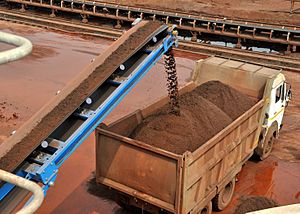Bulk material handling facts for kids
Bulk material handling is a special field of engineering that focuses on moving and storing large amounts of loose, dry materials. Think of things like grain, coal, sand, or ore. This process uses different types of machines and storage places to transport these materials from one spot to another, often over long distances. It's a crucial part of many industries, helping to get raw materials where they need to go for manufacturing, energy production, or construction.
Contents
What is Bulk Material Handling?
Bulk material handling is all about moving and storing materials that are not packaged. These materials are usually in a loose form, like powders, granules, or lumps. Imagine a huge pile of sand or a mountain of coal; handling these in large quantities requires special tools and systems. This field designs the equipment and systems needed to do this safely and efficiently.
Why is it Important?
Moving materials in bulk is super important for many reasons:
- Industry: Factories need raw materials like iron ore for steel or grain for food. Bulk handling systems make sure these materials arrive quickly.
- Energy: Power plants often burn coal to make electricity. Bulk handling moves tons of coal from mines to the plants.
- Construction: Sand, gravel, and cement are moved in bulk for building roads, bridges, and buildings.
- Cost Savings: Moving large amounts at once is much cheaper than moving them in small packages.
- Efficiency: These systems can move materials very fast, saving time and labor.
Types of Materials Handled
Many different kinds of materials are handled in bulk. They can be very fine powders, small grains, or even large rocks.
Common Bulk Materials
- Minerals: Things like iron ore, copper ore, coal, and limestone. These are often dug from the ground.
- Agricultural Products: Grains such as wheat, corn, rice, and soybeans. Also, animal feed and fertilizers.
- Construction Materials: Sand, gravel, crushed stone, and cement.
- Chemicals: Many chemicals used in industries are handled as powders or granules.
Equipment Used in Bulk Handling
Bulk material handling systems use a mix of stationary (fixed) and mobile (moving) machines, along with large storage areas.
Stationary Machinery
These are machines that stay in one place and are often part of a larger system.
- Conveyor Belts: These are like giant moving sidewalks for materials. They carry materials horizontally or at an angle over long distances. They are very common in mines, factories, and ports.
- Bucket Elevators: These lift materials vertically using buckets attached to a chain or belt. They are great for moving materials up to tall silos.
- Screw Conveyors: These use a rotating spiral blade inside a tube to push materials along. They are good for moving powders and sticky materials over shorter distances.
- Chutes and Hoppers: Chutes are sloped channels that let materials slide down by gravity. Hoppers are funnel-shaped containers that hold materials before they are loaded onto something else.
Mobile Equipment
These machines can move around and are used for loading, unloading, and moving materials within a site.
- Loaders: These are large vehicles with a front bucket, used to scoop up materials from piles and load them into trucks or hoppers.
- Excavators: While also used for digging, some excavators are equipped to load bulk materials.
- Dozers: These machines with a large blade push materials around, often to create piles or feed hoppers.
- Stackers and Reclaimers: These are huge machines used in large storage yards. Stackers build up piles of material, while reclaimers dig into the piles to load materials onto conveyors.
Storage Facilities
Storing bulk materials safely and efficiently is just as important as moving them.
- Silos: These are tall, cylindrical structures, often made of concrete or steel. They are used to store grains, cement, and other dry, flowable materials.
- Stockpiles: These are large, open-air piles of material, often used for coal, ore, sand, or gravel. They are common at mines, ports, and power plants.
- Warehouses: Some bulk materials, especially those sensitive to weather, might be stored inside large warehouses.
How Bulk Handling Systems Work
A typical bulk material handling system involves several steps:
- Receiving: Materials arrive by truck, train, or ship and are unloaded.
- Conveying: The materials are then moved using conveyors, elevators, or other equipment to the next stage.
- Processing (Optional): Sometimes, materials might be crushed, screened, or mixed during the process.
- Storing: Materials are held in silos, stockpiles, or warehouses until needed.
- Reclaiming and Loading: When needed, materials are taken from storage and loaded onto another transport for delivery.
This complex system ensures that huge amounts of materials can be moved around the world, supporting many industries and making modern life possible.
Images for kids




